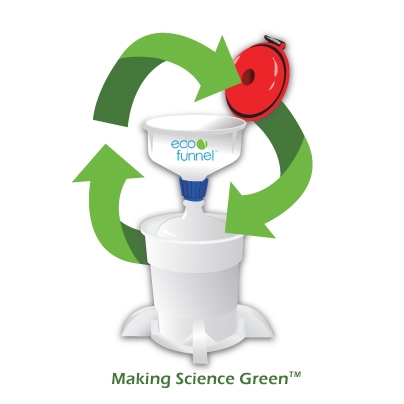10 Ways to Make Your Lab More Sustainable
Laboratories consume 10 times more energy and four times more water than a commercial office space, as well as producing around 6.1 tons of plastic waste annually. The good news is, scientists have a great deal of control over reducing waste and water and energy consumption. Here are a few best practices you can use to start practicing sustainability in the lab today.
1. Use an ECO Funnel

If you know us, then you know ECO Funnel. It’s the easiest way to keep solvent waste contained in the lab, out of your lungs, and out of the atmosphere. Today, if you add up all the ECO Funnels that have been produced as CP Lab Safety has grown, we are currently preventing about 1,000 gallons of solvent every day from entering the atmosphere.
2. Order from sustainable suppliers
Do your research. Find suppliers that are eco-conscious (Maybe we’re tooting our own horn a little bit, but CP Lab Safety is Bay Area Green Certified), and find products made from recycled plastics whenever possible. Test tube racks and conical tubes are a couple of examples of items that can be found made from recycled materials. Choose greener cleaning products like recycled paper towels and ecofriendly floor cleaners.
3. Conserve energy where possible
Be mindful of turning off lights and electronics when not in use, just as you do in your own home. Place signage around light switches and computers to remind others in the lab to turn them off.
4. Check your freezers
This will also contribute greatly to conserving energy in the lab. Check the rubber seals to ensure it’s running efficiently and defrost them regularly. Keep up on freezer maintenance requirements. Consolidate freezer space as much as possible in order reduce the number of freezers required.
5. Close the fume hood
An open fume hood is one the biggest drains of energy. When open, it’s pulling room air into the hood and simultaneously pumping in reconditioned outside air. Harvard University found in 2010 that they could reduce their greenhouse gas emissions by 300 metric tons and save $240,000 in a year, just from closing the fume hoods every time they weren’t in use. You can even download a special magnet design to remind others to shut the fume hood.
6. Recycle plastics, reduce waste whenever possible
Use signage recycling signage to encourage everyone to do so. For old equipment, you can sometimes donate unwanted items to nearby labs that need them. Consider having broken equipment repaired instead of throwing it away, or ask repair facilities about equipment recycling services.
7. Reuse boxes and tip boxes
If you can’t recycle it, try to reuse it. Styrofoam boxes can be reused for shipping packages or as ice boxes. Pipette tip waste is usually unavoidable, but you can get refill racks and autoclaving pipette tip boxes. Wash and dry reagent reservoirs and cell scrapers if they are for techniques that don’t require as much sterility. Always use pipette disposal bins like these.
8. Dispose of chemicals responsibly.
Never flush them down the drain! This WILL cause them to end up in our water supply. Follow disposal protocols every single time you dispose of chemicals. Post signage like this wherever possible regarding disposal requirements.
9. Use the most efficient machines for the job, adjust equipment settings.
Make sure you’re on the correct equipment power settings, reducing the output of freezers and PCR machines. You can find equipment and appliances that work more efficiently than others. Using energy star rated appliances is a no brainer and will also save money. Consider innovative machines like VICI.VICI is a high efficiency and low maintenance hydrogen gas generator that eliminates the need for gas cylinders. No caustics are involved, it’s fast and sensitive and produces grade 6 Hydrogen.
10. Use glassware whenever possible.
Many labs are switching back to good old-fashioned glassware due to the harmful effects of plastic. Plastic became king for durability and affordability. While glass is a more expensive investment, it’s also higher in quality and can last longer. It deteriorates slower than plastic and needs to be replaced less often when treated properly.
Using these best practices can make a sizeable difference in a laboratory’s footprint. Science is an important industry, and it doesn’t need to be a wasteful one. Using these best practices can make a sizeable difference in a laboratory’s footprint. Leaders should be implementing a greener culture within their labs thereby influencing everyone to become more conscious of their habits, and the effects they have on our environment.
Recent Posts
-
Disinfecting Surfaces in the Era of Covid and EPA Registered Commercial Disinfectants and Viricides
The disinfection of surfaces at home, in public spaces, and in hospitals and clinics needs to be a …15th Jan 2023 -
Working with Inorganic Acids in the Laboratory: A Practical Guide
Working with Inorganic Acids in the LaboratoryAcids are of great importance in the laboratory and ar …4th Jan 2023 -
The Top 12 Drinking Water Contaminants
1.Lead- from older plumbing systems pre-1986, when lead pipes, solder, and components were banned. …14th Dec 2022

